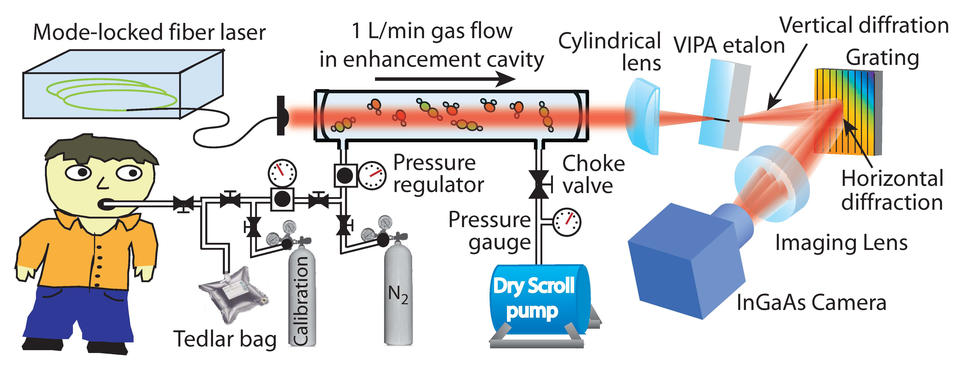
Schematic of a breath analyzer that uses “frequency combs,” an optical tool that led to a recent Nobel Prize in Physics for JILA fellow Jan Hall.
Exhale on a cold winter day and you will see the water vapor coming out of your mouth. Light up your breath with a Nobel-Prize-related tool, and you could potentially detect trace amounts of over 1,000 compounds, some of which provide early warning signs of disease. In a new paper, a team led by Jun Ye, a physicist at JILA, a joint institute of the National Institute of Standards and Technology (NIST) and the University of Colorado at Boulder, has demonstrated an optical technique for simultaneously identifying tiny amounts of a broad range of molecules in the breath, potentially enabling a fast, low-cost screening tool for disease.
"It is exciting to imagine the potential of analyzing all major biomarkers in one's breath at once," says Ye. "For example, nitric oxide can indicate asthma, but it also appears in breath with many other lung diseases, including chronic obstructive pulmonary disease, cystic fibrosis and bronchiectasis. However, if we simultaneously monitor nitric oxide, carbon monoxide, hydro-peroxide, nitrites, nitrates, pentane, and ethane, all important biomarkers for asthma, we can be much more certain for a definitive diagnosis of this important disease."
Existing methods for detecting trace amounts of molecules from the breath are either bulky, slow, limited to specific molecules, unable to distinguish very well between multiple compounds or inaccurate at measuring their concentrations. In this new approach, the researchers analyze human breath with "frequency combs," an optical tool cited in the 2005 Nobel Prize in Physics shared by JILA fellow Jan Hall. Frequency combs are generated by a laser specially designed to produce a series of very short, equally spaced pulses of light. Each pulse may be only a few millionth billionths of a second long. The laser generates light as a series of very narrow frequency peaks equally spaced, like the teeth of a comb, across a broad spectrum.
In the experiment, student volunteers exhaled breath that entered an optical cavity where it was "combed" by the light pulses. By detecting which colors of light were absorbed and in what amounts—essentially looking for light absorbed near the "teeth" of the comb— the researchers could detect specific molecules and their concentrations. For example, a student smoker who participated in the experiment had a level of carbon monoxide that was five times greater than a nonsmoker in the experiment. The optical comb approach allows the researchers to simultaneously analyze a very broad spectrum, covering many possible molecular compounds, with high precision, frequency resolution and sensitivity. The technique is in early phases, and would require clinical trials before it could become available at a doctor's office, but it could lead to one of the first widespread applications of frequency combs.
M.J. Thorpe, D. Balslev-Clausen, M.S. Kirchner and J. Ye. Human breath analysis via cavity enhanced optical frequency comb spectroscopy. Optics Express, Vol. 16, No. 4, February 18, pp. 2387-2397.

